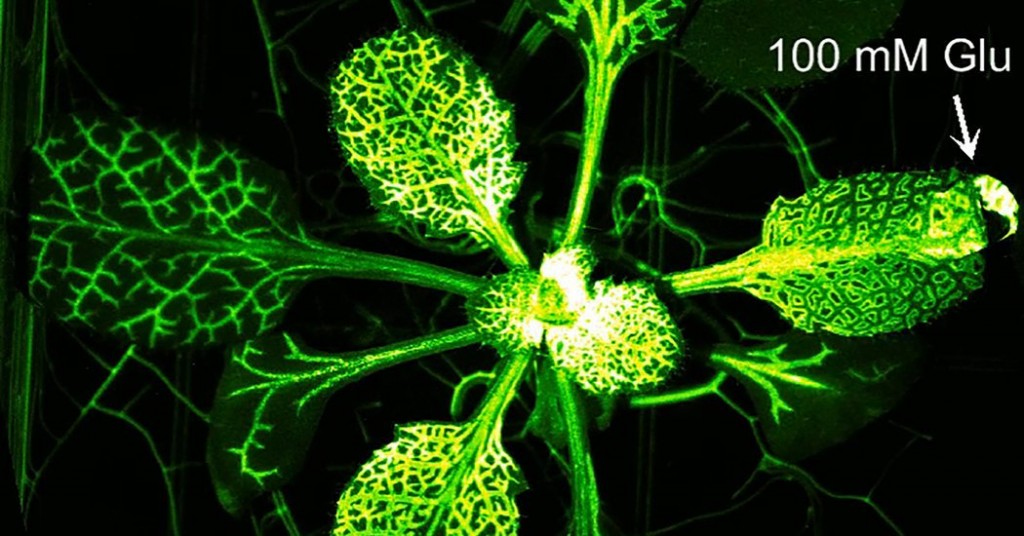Wednesday, 26 June 2019
A communication mechanism in plants that resembles the nervous system in animals

In September 2018, the journal Science published an article with the intriguing title “Nervous system-like signaling in plant defense”. This article describes the discovery of an internal signaling mechanism that some plants use when they are being attacked by plant-eating animals. This mechanism uses glutamate, an excitatory neurotransmitter that plays a well known role in the brains of mammals as well. In these plants, the glutamate molecules bind to a receptor similar to the glutamate receptor in the mammalian brain. By doing so, they increase the concentration of calcium circulating between the plant’s cells (made visible in this photo by means of a fluorescent protein), which warns the rest of the plant that one of its leaves is in the process of being eaten. In just a few minutes, according to this article, the plant activates defense mechanisms to protect its other leaves.
At first, this parallel between a newly discovered signaling system in plants and similar biochemical and functional elements in animal nervous systems might seem surprising. The big difference between plants and animals, after all, is precisely that plants contain the marvelous chlorophyll molecule, which they use to perform photosynthesis. Hence all they have to do is stand in the sun and directly use its energy, in the form of photons, to combine carbon from the carbon dioxide in the air with water and inorganic compounds from the soil to manufacture their cells and grow. Plants don’t have to move through space to find the energy they need for this purpose, and hence don’t need a nervous system.
In contrast, we animals, lacking this capability, have no choice but to observe our environment and move through it in search of energy sources. And because these energy sources are often other animals that are also moving through their environments, animal evolution has produced a very rapid means of signalling: the nervous system.
Because plants can perform photosynthesis, they have not evolved this kind of ultra-fast communication system. But this doesn’t mean that plant cells don’t communicate with one another. For decades, scientists have known that plants cells can emit all kinds of volatile substances that spread through the air and alert other plants of the same species that, for example, an insect is busy nibbling on one of them, so that if they don’t want to get eaten themselves, they had better start synthesizing a poison that this insect cannot tolerate. And thanks to the study described above, we now also know that some molecules can spread within an individual plant and act as a communication system, though more slowly than a nerve impulse (on the order of a minute, which may make them more like a hormonal signal).
From this standpoint of the numerous molecular mechanisms that living cells use to communicate with one another, the title of the article in Science may now seem a bit less surprising. But it is still just as interesting, because it adds one more piece of information to scientists’ rapidly growing knowledge of plant communication mechanisms. The question of sentience in plants has even been addressed in a presentation entitled “What a Plant Knows and Perceives”, made by Frantisek Baluska at the Summer School in Animal Cognition organized by the UQAM Cognitive Sciences Institute in 2018.
Other scientists doing related work include “plant neurobiologist” Stefano Mancuso, who explains the foundations of his approach in an interview, and Evan Thompson, who takes an even broader view in works such as Mind in Life (not just Mind in Animal Nervous Systems).
From the Simple to the Complex | No comments







